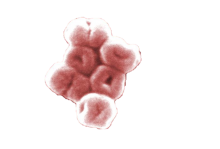
General Information
Acinetobacter [asz−in−ée−toe–back−ter] is a group of Gram-negative bacteria commonly found in soil and water. While there are many types or “species” of Acinetobacter, and all can cause human disease, Acinetobacter baumannii [boe-maa-nee-ie] accounts for about 80% of reported infections. Outbreaks of Acinetobacter infections typically occur in intensive care units and healthcare settings housing very ill patients. Acinetobacter infections rarely occur outside of healthcare settings. Significant outbreaks with this pathogen were tied to soldiers injured during the Iraq war.
Symptoms
Acinetobacter causes a variety of diseases, ranging from pneumonia to serious blood or wound infections, and the symptoms vary depending on the disease. Acinetobacter may also “colonize” or live in a patient without causing infection or symptoms, especially in tracheostomy sites or open wounds.
Transmission
Acinetobacter poses very little risk to healthy people. However, people who have weakened immune systems, chronic lung disease, or diabetes may be more susceptible to infections with Acinetobacter.
Hospitalized patients, especially very ill patients on a ventilator, those with a prolonged hospital stay, those
who have open wounds, or any person with invasive devices like urinary catheters are also at greater risk for Acinetobacter infection. Acinetobacter can be spread to susceptible persons by person-to-person contact or contact with contaminated surfaces.
Treatment
Acinetobacter is often resistant to many commonly prescribed antibiotics; this is often referred to as multidrug-resistant (MDR) Acinetobacter baumannii. Decisions on treatment of infections with Acinetobacter should be made on a case-by-case basis by a healthcare provider. Acinetobacter infection typically occurs in ill patients and can either cause or contribute to death in these patients.
Prevention
Acinetobacter can live on the skin and may survive in the environment for several days, which makes Acinetobacter baumannii prevention a delicate issue. Careful attention to infection control procedures, such as hand hygiene and environmental cleaning, can reduce the risk of transmission. Patients are placed in contact isolation if the pathogen was determined to be MDR.
Guidelines & Recommendations
- Guideline for Disinfection and Sterilization in Healthcare Facilities, 2008
- Guideline for Isolation Precautions: Preventing Transmission of Infectious Agents in Healthcare Settings, 2007
- Management of Multidrug-Resistant Organisms In Healthcare Settings, 2006
- Guideline for Environmental Infection Control in Health-Care Facilities, 2003
- Guidelines for Hand Hygiene in Healthcare Settings, 2002
Cleaning and Disinfection
See table of approved disinfectants in the PDF link below.

